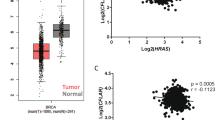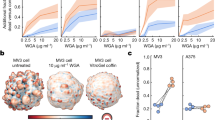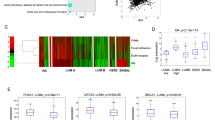Abstract
Epithelial cells must adhere to the extracellular matrix (ECM) for survival, as detachment from matrix triggers apoptosis or anoikis1. Integrins are major mediators of adhesion between cells and ECM proteins, and transduce signals required for cell survival2. Recent evidence suggests that integrin receptors are coupled to growth factor receptors in the regulation of multiple biological functions2; however, mechanisms involved in coordinate regulation of cell survival are poorly understood and mediators responsible for anoikis have not been well characterized. Here, we identify the pro-apoptotic protein Bim as a critical mediator of anoikis in epithelial cells. Bim is strongly induced after cell detachment and downregulation of Bim expression by RNA interference (RNAi) inhibits anoikis. Detachment-induced expression of Bim requires a lack of β1-integrin engagement, downregulation of EGF receptor (EGFR) expression and inhibition of Erk signalling. Overexpressed EGFR was uncoupled from integrin regulation, resulting in the maintenance of Erk activation in suspension, and a block in Bim expression and anoikis. Thus, Bim functions as a key sensor of integrin and growth factor signals to the Erk pathway, and loss of such coordinate regulation may contribute to tumour progression.
This is a preview of subscription content, access via your institution
Access options
Subscribe to this journal
Receive 12 print issues and online access
$209.00 per year
only $17.42 per issue
Buy this article
- Purchase on Springer Link
- Instant access to full article PDF
Prices may be subject to local taxes which are calculated during checkout




Similar content being viewed by others

References
Frisch, S.M. & Screaton, R.A. Anoikis mechanisms. Curr. Opin. Cell Biol. 13, 555–562 (2001).
Miranti, C.K. & Brugge, J.S. Sensing the environment: a historical perspective on integrin signal transduction. Nature Cell Biol. 4, E83–E90 (2002).
Schwartz, M.A. Integrins, oncogenes, and anchorage independence. J. Cell Biol. 139, 575–578 (1997).
Cory, S. & Adams, J.M. The Bcl2 family: regulators of the cellular life-or-death switch. Nature Rev. Cancer 2, 647–656 (2002).
Puthalakath, H. & Strasser, A. Keeping killers on a tight leash: transcriptional and post-translational control of the pro-apoptotic activity of BH3-only proteins. Cell Death Differ. 9, 505–512 (2002).
Zong, W.X., Lindsten, T., Ross, A.J., MacGregor, G.R. & Thompson, C.B. BH3-only proteins that bind pro-survival Bcl-2 family members fail to induce apoptosis in the absence of Bax and Bak. Genes Dev. 15, 1481–1486 (2001).
Cheng, E.H. et al. BCL-2, BCL-X(L) sequester BH3 domain-only molecules preventing BAX- and BAK-mediated mitochondrial apoptosis. Mol. Cell 8, 705–711 (2001).
Rytomaa, M., Martins, L.M. & Downward, J. Involvement of FADD and caspase-8 signalling in detachment-induced apoptosis. Curr. Biol. 9, 1043–1046 (1999).
Soule, H.D. et al. Isolation and characterization of a spontaneously immortalized human breast epithelial cell line, MCF-10. Cancer Res. 50, 6075–6086 (1990).
O'Connor, L. et al. Bim: a novel member of the Bcl-2 family that promotes apoptosis. EMBO J. 17, 384–395 (1998).
Puthalakath, H., Huang, D.C., O'Reilly, L.A., King, S.M. & Strasser, A. The proapoptotic activity of the Bcl-2 family member Bim is regulated by interaction with the dynein motor complex. Mol. Cell 3, 287–296 (1999).
Puthalakath, H. et al. Bmf: a proapoptotic BH3-only protein regulated by interaction with the myosin V actin motor complex, activated by anoikis. Science 293, 1829–1832 (2001).
Howlett, A.R., Bailey, N., Damsky, C., Petersen, O.W. & Bissell, M.J. Cellular growth and survival are mediated by β1 integrins in normal human breast epithelium but not in breast carcinoma. J. Cell Sci. 108, 1945–1957 (1995).
Khwaja, A., Rodriguez-Viciana, P., Wennstrom, S., Warne, P.H. & Downward, J. Matrix adhesion and Ras transformation both activate a phosphoinositide 3-OH kinase and protein kinase B/Akt cellular survival pathway. EMBO J. 16, 2783–2793 (1997).
King, W.G., Mattaliano, M.D., Chan, T.O., Tsichlis, P.N. & Brugge, J.S. Phosphatidylinositol 3-kinase is required for integrin-stimulated AKT and Raf-1/mitogen-activated protein kinase pathway activation. Mol. Cell. Biol. 17, 4406–4418 (1997).
Schulze, A., Lehmann, K., Jefferies, H.B., McMahon, M. & Downward, J. Analysis of the transcriptional program induced by Raf in epithelial cells. Genes Dev. 15, 981–994 (2001).
Rosen, K. et al. Downregulation of the pro-apoptotic protein Bak is required for the ras-induced transformation of intestinal epithelial cells. Curr. Biol. 8, 1331–1334 (1998).
Baron, V. & Schwartz, M. Cell adhesion regulates ubiquitin-mediated degradation of the platelet-derived growth factor receptor β. J. Biol. Chem. 275, 39318–39323 (2000).
Wang, F. et al. Reciprocal interactions between β1-integrin and epidermal growth factor receptor in three-dimensional basement membrane breast cultures: a different perspective in epithelial biology. Proc. Natl Acad. Sci. USA 95, 14821–14826 (1998).
Muthuswamy, S.K., Li, D., Lelievre, S., Bissell, M.J. & Brugge, J.S. ErbB2, but not ErbB1, reinitiates proliferation and induces luminal repopulation in epithelial acini. Nature Cell Biol. 3, 785–792 (2001).
Dijkers, P.F. et al. FKHR-L1 can act as a critical effector of cell death induced by cytokine withdrawal: protein kinase B-enhanced cell survival through maintenance of mitochondrial integrity. J. Cell Biol. 156, 531–542 (2002).
Kohn, A.D. et al. Construction and characterization of a conditionally active version of the serine/threonine kinase Akt. J. Biol. Chem. 273, 11937–11943 (1998).
Datta, S.R. et al. Akt phosphorylation of BAD couples survival signals to the cell-intrinsic death machinery. Cell 91, 231–241 (1997).
Leverrier, Y. et al. Role of PI3-kinase in Bcl-X induction and apoptosis inhibition mediated by IL-3 or IGF-1 in Baf-3 cells. Cell Death Differ. 6, 290–296 (1999).
Cardone, M.H. et al. Regulation of cell death protease caspase-9 by phosphorylation. Science 282, 1318–1321 (1998).
Le Gall, M. et al. The p42/p44 MAP kinase pathway prevents apoptosis induced by anchorage and serum removal. Mol. Biol. Cell 11, 1103–1112 (2000).
Jost, M., Huggett, T.M., Kari, C. & Rodeck, U. Matrix-independent survival of human keratinocytes through an EGF receptor/MAPK-kinase-dependent pathway. Mol. Biol. Cell 12, 1519–1527 (2001).
Shinjyo, T. et al. Downregulation of Bim, a proapoptotic relative of Bcl-2, is a pivotal step in cytokine-initiated survival signaling in murine hematopoietic progenitors. Mol. Cell. Biol. 21, 854–864 (2001).
Biswas, S.C. & Greene, L.A. NGF down-regulates the BH3-only protein Bim and suppresses its pro-apoptotic activity by phosphorylation. J. Biol. Chem. 277, 49511–49516 (2002).
Weston, C.R. et al. Activation of ERK1/2 by deltaRaf-1:ER* represses Bim expression independently of the JNK or PI3K pathways. Oncogene 22, 1281–1293 (2003).
Ley, R., Balmanno, K., Hadfield, K., Weston, C.R. & Cook, S.J. Activation of the ERK1/2 signalling pathway promotes phosphorylation and proteasome-dependent degradation of the BH3-only protein Bim. J. Biol. Chem. 278, 18811–18816 (2003).
Evan, G. & Littlewood, T. A matter of life and cell death. Science 281, 1317–1322 (1998).
Edwards, P.A. Tissue reconstitution, or transgenic mammary gland, technique for modeling breast cancer development. Cancer Treat Res. 83, 23–36 (1996).
Ory, D.S., Neugeboren, B.A. & Mulligan, R.C. A stable human-derived packaging cell line for production of high titer retrovirus/vesicular stomatitis virus G pseudotypes. Proc. Natl Acad. Sci. USA 93, 11400–11406 (1996).
Ma, X.J. et al. Gene expression profiles of human breast cancer progression. Proc. Natl Acad. Sci. USA 100, 5974–5979 (2003).
Acknowledgements
We would like to thank O. Gozani, R. Greenberg and members of the Brugge lab for stimulating discussions. We would like to thank Ariad Pharmaceuticals for providing AP1510 (www.ariad.com/regulationkits). This work was supported by grants from National Cancer Institute, Aventis Pharmaceuticals and the American Cancer Society (to J.S.B.); a Susan Komen Breast Cancer Postdoctoral Fellowship (to M.J.R.); an HHMI Physician Postdoctoral Fellowship (to J.D.); a Massachusetts Breast Cancer Research Award (to S.K.M.).
Author information
Authors and Affiliations
Corresponding author
Ethics declarations
Competing interests
The authors declare no competing financial interests.
Supplementary information
Supplementary Information, Fig. S1
Supplementary Information, Fig. S2 (PDF 103 kb)
Supplementary Information, Fig. S3
Rights and permissions
About this article
Cite this article
Reginato, M., Mills, K., Paulus, J. et al. Integrins and EGFR coordinately regulate the pro-apoptotic protein Bim to prevent anoikis. Nat Cell Biol 5, 733–740 (2003). https://doi.org/10.1038/ncb1026
Received:
Accepted:
Published:
Issue Date:
DOI: https://doi.org/10.1038/ncb1026
This article is cited by
-
Anoikis and cancer cell differentiation: novel modes of shikonin derivatives anticancer action in vitro
Molecular Biology Reports (2024)
-
A bibliometric and knowledge-map analysis of anoikis from 2003 to 2022
Apoptosis (2024)
-
Anoikis resistance––protagonists of breast cancer cells survive and metastasize after ECM detachment
Cell Communication and Signaling (2023)
-
Epigenetic suppression of PGC1α (PPARGC1A) causes collateral sensitivity to HMGCR-inhibitors within BRAF-treatment resistant melanomas
Nature Communications (2023)
-
ErbB2/Her2-dependent downregulation of a cell death-promoting protein BLNK in breast cancer cells is required for 3D breast tumor growth
Cell Death & Disease (2022)


